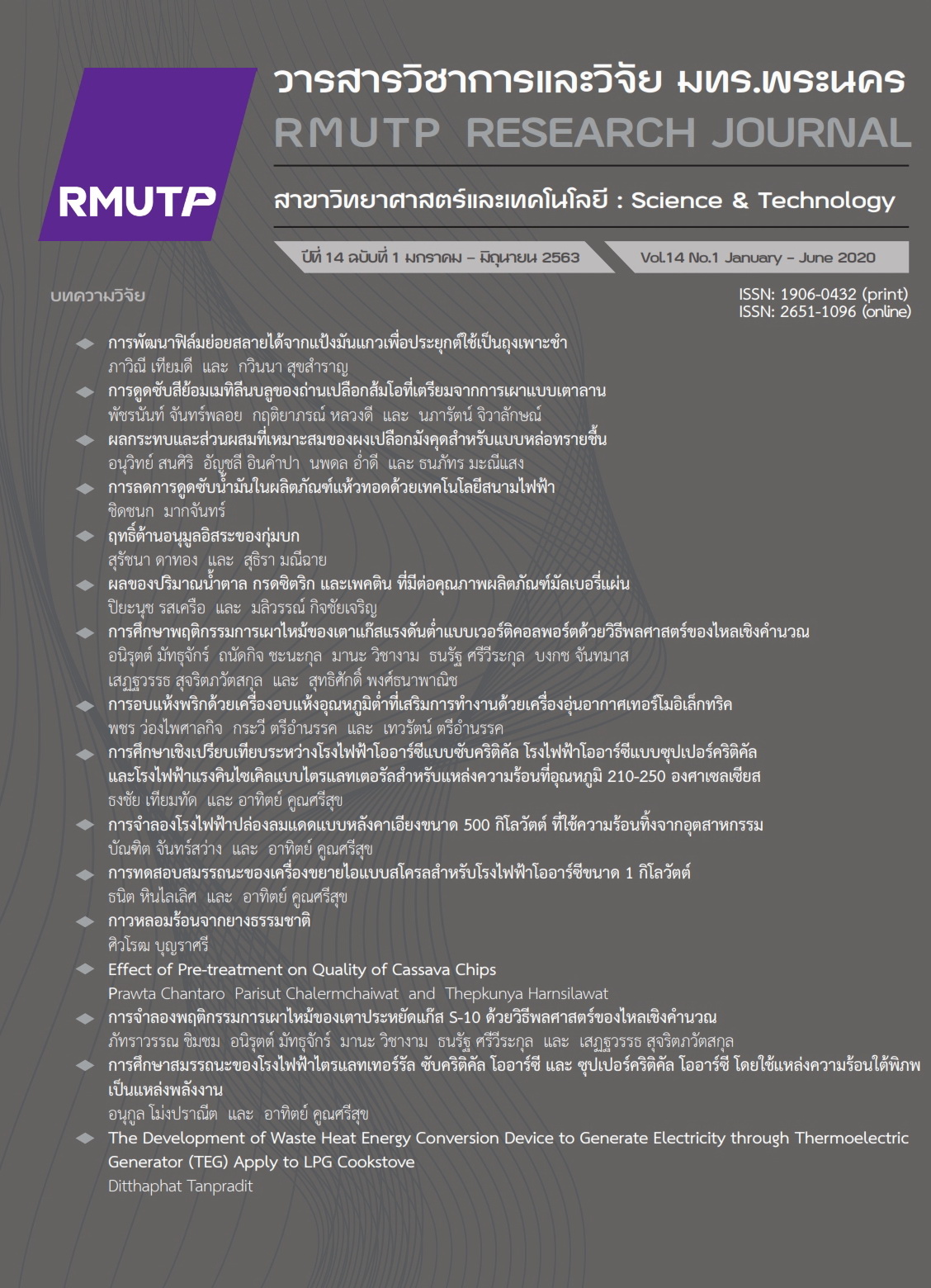Simulation of a 500 kW Sloped Solar Chimney Power Plant Powered by Industrial Waste Heat
Main Article Content
Abstract
The solar chimney power plant (SCPP) has been proposed as a promising alternative power plant. According to the literature, the chimney for commercial-scale SCPPs should be about 1 km high. The construction of these tall chimneys is very challenging and the construction cost is enormous. The sloped solar chimney power plant (SSCPP) is a variation of the SCPP. One of the SSCPP’s prominent feature is that its collector is sloped, and then its chimney can be shorter than that of the SCPP. This leads to a lower investment cost of SSCPPs compared with that of SCPPs. Also, previous studies show that the industrial waste heat potential of Thailand is considerable and should be investigated. As a result, this study developed a mathematical model for designing a sloped solar chimney power plant powered by industrial waste heat (SSCPP-WH). The model was justified by validation using experimental data. Then several SSCPPs with different geometrical dimensions were simulated to determine a proper dimension that has the lowest levelized cost of electricity (LCOE). It was found that the LCOE is about 0.14 USD/kWh, the payback period is about 11 years, system efficiency of 1.3% and collector efficiency of 36%. for an SSCPP-WH with a collector area of 49,000 m2, chimney height of 45m, flow area ratio between solar collector inlet and solar collector outlet (AR12) of 14 and waste heat of 10 MW. It was also found that the payback period of SSCPP with no supplied waste heat is lower than that of some SSCPP-WHs. To make sure that the payback period for the SSCPP-WH is faster than that of SSCPP with no waste heat, a ratio of the supplied waste heat to the absorbed solar energy of the SSCPP-WH must be greater than 0.34.
Article Details
References
EnviroMission Limited. (2017, December 6). Solar Chimney Power Plant. [Online]. Available: http://www.enviromission.com.au
W. Haaf, “Solar Chimneys: Part II: Preliminary Test Results from the Manzanares Pilot Plant,” International Journal of Solar Energy, vol. 2, no. 2, pp. 141-161, Jan. 1984.
A. Zandian and M. Ashjaee, “The thermal efficiency improvement of a steam Rankine cycle by innovative design of a hybrid cooling tower and a solar chimney concept,” Renewable Energy, vol. 51, pp. 465–473, Mar. 2013.
Z. Zou and S. He, “Modeling and characteristics analysis of hybrid cooling-tower-solar-chimney system,” Energy Conversion and Management, vol. 95, pp. 59–68, May 2015.
A. Mourtada, A.N. Arkahdan and Y.M. Karout, “Solar chimney electricity from the sun,” in 2012 International Conference on Renewable Energies for Developing Countries (REDEC), Beirut, Lebanon, Nov. 2012, pp. 1–8.
E. Bilgen, J. Rheault, “Solar chimney power plants for high latitudes,” Solar Energy, vol. 79, no. 5, pp. 449–458, Nov. 2005.
F. Cao, L. Zhao and L. Guo, “Simulation of a sloped solar chimney power plant in Lanzhou,” Energy Conversion and Management, vol. 52, no. 6, pp. 2360–2366, Jun. 2011.
Koonsrisuk A, “Mathematical modeling of sloped solar chimney power plants,” Energy, vol. 47, no. 1, pp. 582–589, Nov. 2012.
S. Kalash, W. Naimeh and S. Ajib, “Experimental investigation of the solar collector temperature field of a sloped solar updraft power plant prototype,” Solar Energy, vol. 98, pp. 70–77, Dec. 2013.
A. Koonsrisuk, “Comparison of conventional solar chimney power plants and sloped solar chimney power plants using second law analysis,” Solar Energy, vol. 98, pp. 78–84, Dec. 2013.
F. Cao, L. Zhao, H. Li and L. Guo, “Performance analysis of conventional and sloped solar chimney power plants in China,” Applied Thermal Engineering, vol. 50, no. 1, pp. 582–592, Jan. 2013.
X. Zhou, S. Yuan and M.A. dos S. Bernardes, Sloped-collector solar updraft tower power plant performance,” International Journal of Heat and Mass Transfer, vol. 66, pp. 798–807, Nov. 2013.
T. P. Fluri, J. P. Pretorius, C. V. Dyk, T. V. Backström D. G. Kröger and G. P. A. G. V. Zijl, “Cost analysis of solar chimney power plants,” Solar Energy, vol. 83, no. 2, pp. 246–256, Feb. 2009.
J. Schlaich, R. Bergermann, W. Schiel and G. Weinrebe, “Sustainable Electricity Generation with Solar Updraft Towers,” Structural Engineering International, vol. 14, no. 3, pp. 225–229, Aug. 2004.
E. P. Sakonidou, T. D. Karapantsios, A. I. Balouktsis and D. Chassapis, “Modeling of the optimum tilt of a solar chimney for maximum air flow,” Solar Energy, vol. 82, no. 1, pp. 80–94, Jan. 2008.
Waste Heat Recovery Guide, EnConLab. EnConLab, Bangkok, King Mongkut's University of Technology Thonburi, 2017.
J. A. Duffie and W. A. Beckman, Solar engineering of thermal processes, Hoboken: John Wiley, 2013.
M. -H. Huang, L. Chen, Y. –L. He, J. –J. Cao and W. –Q. Tao, “A two-dimensional simulation method of the solar chimney power plant with a new radiation model for the collector,” International Communications in Heat and Mass Transfer, vol. 85, pp. 100-106, Jul. 2017.
N. Pasumarthi, S.A. Sherif, “Experimental and theoretical performance of a demonstration solar chimney model-Part I: Mathematical model development,” International Journal of Energy Research, vol. 22, no. 3, pp. 277–288, 1998.
M. A. dos S. Bernardes, A. Voß and G. Weinrebe, “Thermal and technical analyses of solar chimneys,” Solar Energy, vol. 75, no. 6, pp. 511–524, Dec. 2003.
A. Koonsrisuk and T. Chitsomboon, “Effects of flow area changes on the potential of solar chimney power plants,” Energy, vol. 51, pp. 400–406, Mar. 2013.
Department of Alternative Energy Development and Efficiency, Ministry of Energy, Total radiation potential (Solar power from measurements), 2017.
The average temperature in each month of each province. (2017, December 7). [Online]. Available: http://www.e-report.energy.go.th/
weather.html
F. Cao, H. Li, L. Zhao and L. Guo, “Economic analysis of solar chimney power plants in Northwest China,” Journal of Renewable and Sustainable Energy, vol. 5, no. 2, p. 021406, Mar. 2013.


